
“Do snakes sleep in trees?” It’s a question that has piqued the curiosity of many nature enthusiasts and casual observers alike.
In this article, we delve deep into the world of snakes and their intriguing resting habits, particularly their affinity for trees.
We’ve explored various factors, from the anatomy of tree-climbing snakes to the advantages trees offer these serpentine creatures.
By the end of this read, you’ll gain a comprehensive understanding of why some snakes might choose the lofty branches over the ground for their slumber.
Whether you’re a reptile aficionado or just someone looking to quench their thirst for knowledge, this article promises insights that will both inform and fascinate you.
Table of Contents
- 1 Do Snakes Sleep In Trees? Yes, They Do
- 2 The Sleeping Habits of Snakes
- 3 Do Snakes Sleep in Trees?
- 4 Advantages of Sleeping in Trees for Snakes
- 5 How Do Snakes Climb Trees?
- 6 Myths and Misconceptions about Snakes in Trees
- 7 Safety Tips: Encountering a Snake in a Tree
- 8 Other Habitats Preferred by Snakes for Resting
- 9 Final Word
- 10 FAQ
Do Snakes Sleep In Trees? Yes, They Do
Yes, many snakes do sleep in trees. Arboreal snake species, such as the Green Tree Python and the Boomslang, have evolved to thrive in treetop environments. Trees offer these snakes safety from ground predators, a stable microclimate, and proximity to prey like birds and insects. While resting or sleeping, these snakes coil around branches, blending seamlessly with the foliage. However, it’s essential to note that not all snake species are tree-dwellers.
While many snakes can climb trees, they might not necessarily choose them as their primary resting spots. The choice often depends on the snake’s species, habitat, and individual preferences.
The Sleeping Habits of Snakes
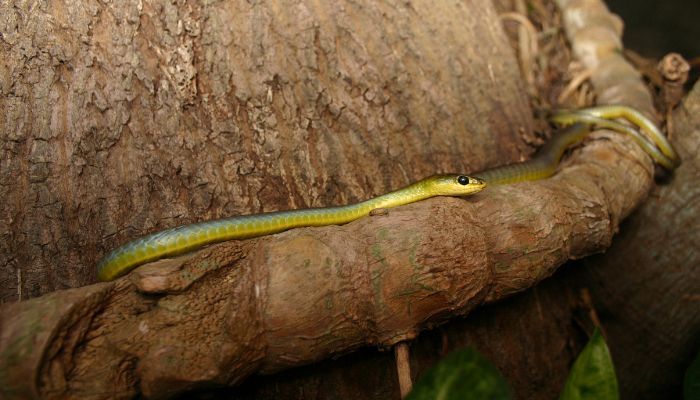
Imagine you’re on a serene walk through a dense forest, the sun is setting, and the world is preparing to rest. Birds are returning to their nests, and the nocturnal creatures are just beginning to stir.
As you look up, you notice a peculiar sight: a snake, coiled comfortably on a tree branch, seemingly in deep slumber. This sight might leave you wondering, “Do snakes really sleep in trees?”
How snakes sleep: the science behind it
Snakes, like all living creatures, need their rest. But their sleep is a tad different from ours. While humans have REM (Rapid Eye Movement) sleep, snakes don’t. Instead, they enter a state called torpor.
This is a deep, restful state where their metabolic rate drops, and they become less responsive to external stimuli. It’s not quite the dream-filled sleep we experience, but it’s restorative nonetheless.
Now, let’s talk about trees.
Trees offer an elevated platform, which can be an advantage for many reasons.
For one, it keeps them away from ground predators. Imagine being a snake and having to constantly worry about being someone else’s midnight snack. Not fun, right? Trees provide a sanctuary from such threats.
Moreover, trees can offer a more stable temperature range, especially during the night when the ground can get much colder.
But not all snakes will choose trees as their resting spot. Which brings us to our next point.
Differences in sleeping patterns among various snake species
Just as humans have preferences for soft versus firm mattresses, snakes too have their own sleeping preferences. And these preferences are largely influenced by their species and habitat.
Arboreal snakes, such as the Green Tree Python or the Boomslang, are perfectly adapted to life in the trees. Their long, slender bodies and prehensile tails make it easy for them to coil around branches and rest.
For these species, sleeping in trees is as natural as it is for us to sleep in beds.
On the other hand, terrestrial snakes, like the rattlesnake or the king cobra, prefer the solid ground. They might seek out burrows, rock crevices, or other hiding spots to catch some shut-eye.
While they can climb trees, and occasionally might, it’s not their go-to spot for a nap.
While not all snakes sleep in trees, many do, especially those adapted to an arboreal lifestyle. So, the next time you’re out on a nature walk, don’t forget to look up. You might just spot a snake catching some Z’s on a branch!
Do Snakes Sleep in Trees?
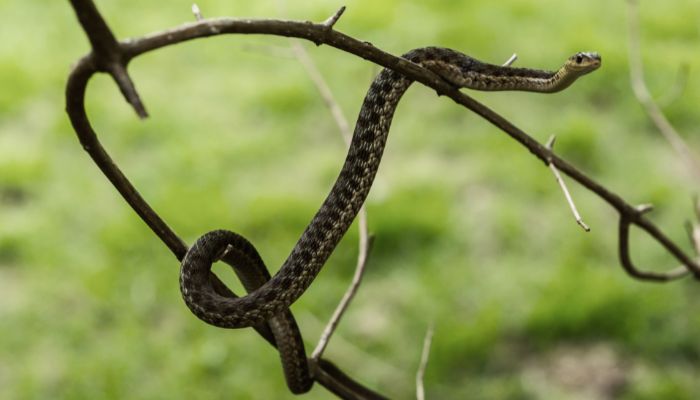
The image of a snake might conjure up thoughts of a slithering creature on the ground, hiding under rocks or in the grass.
But what if I told you that many snakes prefer the high life? That’s right, many snakes love trees, and they often climb them to rest, hunt, or even sleep. Let’s delve deeper into this fascinating behavior.
The Black Rat Snake’s Affinity for Trees
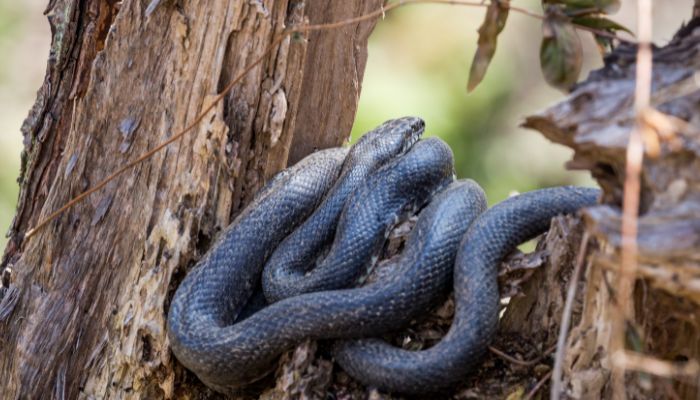
Enter the Black Rat Snake, a perfect example of a tree-loving serpent. This snake, often found in North America, is known for its impressive climbing skills.
With its strong, muscular body, it can scale tree trunks with ease, often in search of its favorite meal: birds and their eggs.
But it’s not just the hunt that takes them up there. Black Rat Snakes have been observed using tree hollows and cavities as resting spots.
These natural hideouts offer protection, and the insulating properties of tree bark provide a cozy environment, making them an ideal spot for a nap or even a long slumber.
Other Tree-Dwelling Snakes
While the Black Rat Snake might be a poster child for arboreal snakes in North America, it’s not alone in its love for trees. The world of snakes is vast and diverse, and many species have evolved to thrive in treetops.
For instance, the Green Tree Python from Australia and New Guinea is a sight to behold. With its vibrant green coloration, it camouflages perfectly among the leaves.
Unlike the Black Rat Snake, which might venture down more frequently, the Green Tree Python spends a significant portion of its life coiled on tree branches.
Then there’s the Boomslang from Africa, a highly venomous snake. It’s an agile climber, often found resting in trees, waiting patiently for its next meal to come by, be it a bird, a lizard, or a small mammal.
Comparatively, while the Black Rat Snake climbs trees primarily for hunting and occasionally resting, species like the Green Tree Python are almost entirely arboreal, making trees their permanent residence.
In essence, the world of snakes is full of surprises. From the ground to the treetops, these fascinating creatures have adapted to a myriad of environments, showcasing the incredible diversity and adaptability of nature.
So, the next time you’re out in the woods, remember to not just watch your step, but also to look up. You never know who might be napping above!
Advantages of Sleeping in Trees for Snakes
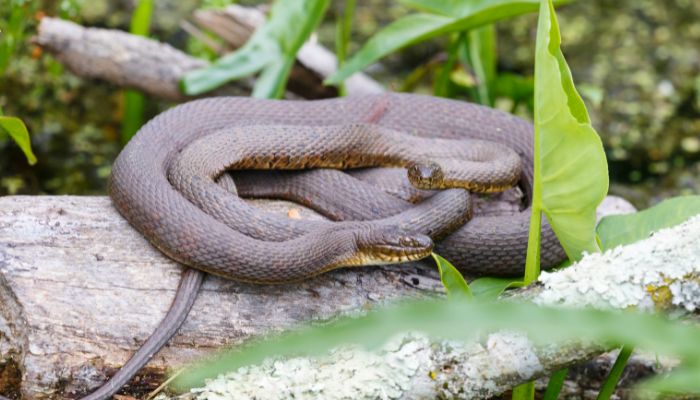
When you think of a snake, the image that likely comes to mind is of it slithering on the ground, camouflaged among the leaves or sand. But many snakes have taken to the trees, finding solace and strategic advantage in the branches above.
Why, you ask?
Let’s explore the compelling reasons that drive these serpents skyward.
Safety from ground predators
The ground is a bustling place, teeming with potential threats for a resting snake. Larger animals, other predatory reptiles, or even bigger snakes could pose a danger. By taking to the trees, snakes place a literal and metaphorical barrier between themselves and these threats.
It’s akin to us choosing to sleep in a locked room rather than an open courtyard. In the branches, snakes can coil up, blend in, and rest without the constant threat of being ambushed.
Better temperature regulation
Trees, with their dense canopies and layered structures, offer a unique microclimate. During hot days, the shade provided by leaves can be significantly cooler than the sun-baked ground.
Conversely, during cold nights, the insulating properties of bark and the heat retained by the tree can provide a warmer resting spot than the chilly ground below.
For cold-blooded creatures like snakes, which rely on external sources to regulate their body temperature, this can be a game-changer. It ensures they remain agile and ready for action, be it hunting or evading threats.
Proximity to prey
Let’s face it, trees are a hub of activity. They’re home to birds, insects, mammals, and other potential meals for a hungry snake. By choosing to rest in trees, snakes position themselves right in the middle of a buffet. It’s like sleeping in a 24/7 diner!
When hunger strikes, they don’t have to travel far. A quick, stealthy move might reward them with a meal, right in their treetop abode.
How Do Snakes Climb Trees?
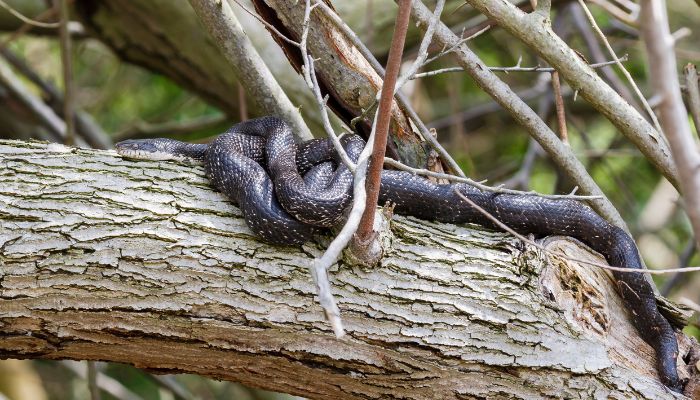
Ever watched a snake climb a tree and wondered, “How on earth do they do that without arms or legs?” It’s a sight that can leave many baffled.
But snakes, with their unique anatomy and adaptive techniques, have mastered the art of tree climbing. Let’s unravel this mystery.
The anatomy of a climbing snake
At the heart of a snake’s climbing ability is its muscular, elongated body. Unlike us, who rely on specific limbs for movement, every inch of a snake’s body is designed for motion.
Their ventral scales (those on the underside) are specially structured to grip surfaces, providing traction.
Additionally, their flexible spine, combined with strong muscles, allows them to push against surfaces and propel themselves upwards.
Techniques used by snakes to ascend trees
Snakes employ a few different techniques when climbing:
- Concertina method: Imagine an accordion being stretched out and then compressed. Snakes using this method will anchor a part of their body to the tree, stretch out further up, and then pull the rest of their body along.
- Lateral undulation: This is the classic “S” shape movement we often associate with snakes. They push off from any irregularities or protrusions on the tree’s surface, creating a wave-like motion that propels them upwards.
- Bridging: For shorter spans, a snake might stretch from one tree to another, using its body strength and tension to move across.
Myths and Misconceptions about Snakes in Trees
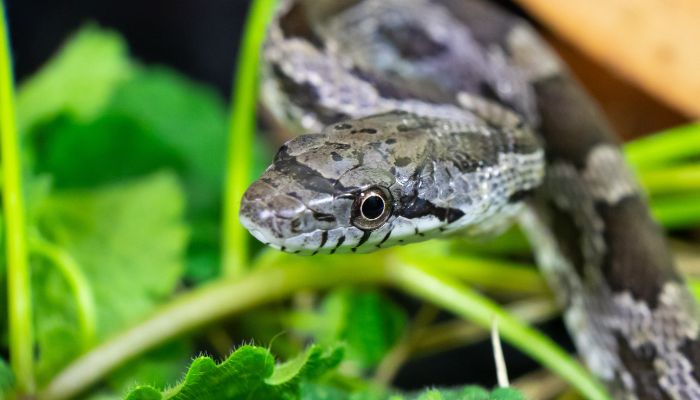
With the mystique surrounding snakes, it’s no surprise that there are numerous myths and misconceptions, especially when it comes to their arboreal antics.
Common myths debunked
Myth 1: All snakes can climb trees.
Truth: While many snakes have the ability to climb, not all species are adept at it. Some are strictly terrestrial.
Myth 2: Snakes in trees will always drop down on unsuspecting passersby.
Truth: Snakes don’t have any interest in dropping down unless they’re threatened or see potential prey. Most of the time, they’d rather stay unnoticed.
The truth about snake attacks from trees
While there have been isolated incidents of snakes striking from trees, it’s essential to understand the context. Most of these cases involve someone threatening the snake or being mistaken for prey.
Snakes don’t attack humans out of malice; they either do it out of defense or by accident.
In essence, while snakes in trees can be a fascinating subject, it’s crucial to approach it with understanding and respect.
By debunking myths and misconceptions, we can appreciate these remarkable creatures for what they truly are: masters of adaptation and survival.
Safety Tips: Encountering a Snake in a Tree
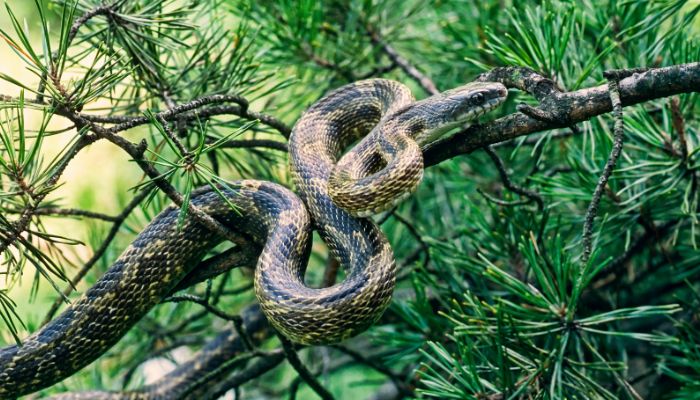
Strolling through a forest or even your backyard, you might occasionally spot a snake resting in a tree. While the sight can be startling, it’s essential to know how to react to ensure safety for both you and the snake.
What to do
- Stay Calm: Panicking can lead to hasty actions that might provoke the snake.
- Keep a Safe Distance: Give the snake its space. Most snakes will not attack unless they feel threatened.
- Avoid Provoking: Do not throw objects or try to dislodge the snake.
What Not to do
- Attempt to Handle: Even if you believe the snake is non-venomous, it’s best to leave it be.
- Linger Around: If the snake is blocking your path, wait for a while or find an alternate route.
Importance of respecting wildlife
Every creature, including snakes, plays a vital role in our ecosystem. By respecting their space and understanding their behavior, we promote coexistence and reduce unnecessary conflicts.
Remember, snakes aren’t in the tree to harm you; they’re merely following their natural instincts.
Other Habitats Preferred by Snakes for Resting
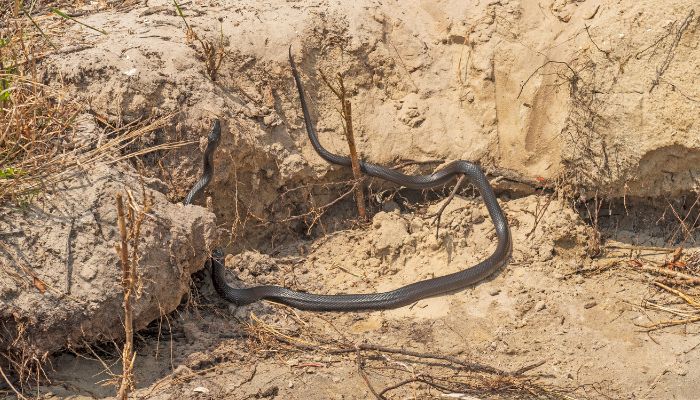
While trees are a favored spot for many snakes, they’re not the only choice. Depending on the species and the environment, snakes have a variety of preferred resting spots.
Ground burrows and their advantages
Many snakes, especially those in arid regions, opt for ground burrows. These underground hideouts offer protection from predators and extreme weather conditions.
The stable temperature inside a burrow can be a haven for cold-blooded snakes, protecting them from the scorching sun or freezing cold.
Rock crevices and other hiding spots
Rocky terrains provide ample hiding spots for snakes. Crevices, gaps between stones, or underneath rocks can be ideal resting places.
These spots offer protection and often come with the added advantage of being near water sources or prey.
The allure of trees: height and safety
As we’ve explored, trees offer a vantage point. The height provides a bird’s-eye view of potential prey, safety from ground-based threats, and a stable microclimate.
For arboreal snake species, trees are more than just a resting spot; they’re home.
Final Word
In our journey through the world of snakes, we’ve uncovered some intriguing facets of their behavior and habitats.
From their unique sleeping patterns to their preference for tree-top slumbers, snakes continue to be creatures of wonder and adaptability.
Their choice of resting spots, be it trees, burrows, or rock crevices, showcases their versatility and resilience. As we wrap up, it’s essential to appreciate the intricate balance of nature and the role snakes play in maintaining it.
Their tree-dwelling habits are just one of the many marvels in the fascinating world of snakes.
FAQ
How can you tell when a snake is sleeping?
Snakes don’t have eyelids, so they can’t close their eyes. However, when a snake is resting or in torpor (a sleep-like state), its body becomes less responsive, and its breathing slows down. They’ll often find a safe, secluded spot and remain motionless during this period.
Where do snakes go in the dark?
Snakes are ectothermic, meaning their body temperature is regulated by the environment. In the dark, especially during colder nights, snakes seek warmer places to maintain their body temperature. This could be underground burrows, rock crevices, or even inside tree hollows.
Where do snakes hibernate?
In colder regions, snakes hibernate to survive the winter. They’ll often retreat to dens, sometimes with other snakes, to stay warm. These dens, called hibernacula, can be underground burrows, rock formations, or other places that offer protection from the cold.
What part of the day are snakes most active?
The activity pattern of snakes varies by species. Some snakes are diurnal (active during the day), while others are nocturnal (active at night). Factors influencing their activity include temperature, humidity, and prey availability. For instance, in extremely hot environments, snakes might become more active during the cooler parts of the day or night to avoid the scorching heat.

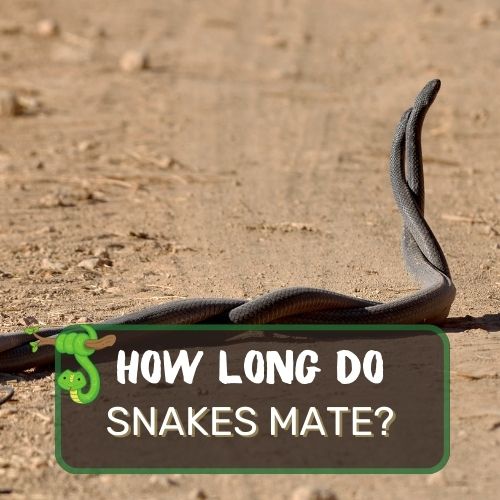


0 Comments